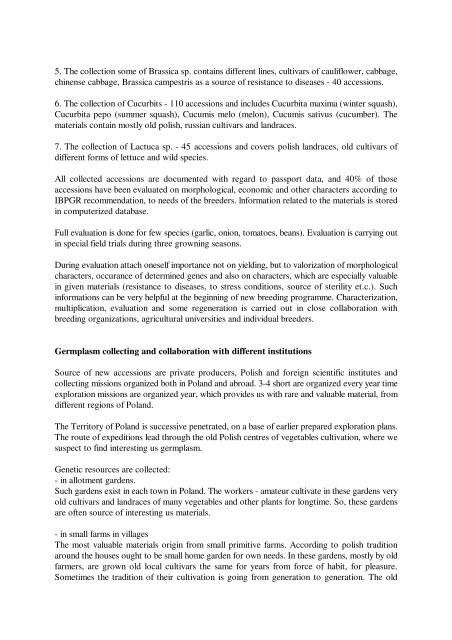Integration of Conservation Strategies of Plant Genetic ... - Genres
Integration of Conservation Strategies of Plant Genetic ... - Genres
Integration of Conservation Strategies of Plant Genetic ... - Genres
Create successful ePaper yourself
Turn your PDF publications into a flip-book with our unique Google optimized e-Paper software.
5. The collection some <strong>of</strong> Brassica sp. contains different lines, cultivars <strong>of</strong> cauliflower, cabbage,<br />
chinense cabbage, Brassica campestris as a source <strong>of</strong> resistance to diseases - 40 accessions.<br />
6. The collection <strong>of</strong> Cucurbits - 110 accessions and includes Cucurbita maxima (winter squash),<br />
Cucurbita pepo (summer squash), Cucumis melo (melon), Cucumis sativus (cucumber). The<br />
materials contain mostly old polish, russian cultivars and landraces.<br />
7. The collection <strong>of</strong> Lactuca sp. - 45 accessions and covers polish landraces, old cultivars <strong>of</strong><br />
different forms <strong>of</strong> lettuce and wild species.<br />
All collected accessions are documented with regard to passport data, and 40% <strong>of</strong> those<br />
accessions have been evaluated on morphological, economic and other characters according to<br />
IBPGR recommendation, to needs <strong>of</strong> the breeders. lnformation related to the materials is stored<br />
in computerized database.<br />
Full evaluation is done for few species (garlic, onion, tomatoes, beans). Evaluation is carrying out<br />
in special field trials during three growning seasons.<br />
During evaluation attach oneself importance not on yielding, but to valorization <strong>of</strong> morphological<br />
characters, occurance <strong>of</strong> determined genes and also on characters, which are especially valuable<br />
in given materials (resistance to diseases, to stress conditions, source <strong>of</strong> sterility et.c.). Such<br />
informations can be very helpful at the beginning <strong>of</strong> new breeding programme. Characterization,<br />
multiplication, evaluation and some regeneration is carried out in close collaboration with<br />
breeding organizations, agricultural universities and individual breeders.<br />
Germplasm collecting and collaboration with different institutions<br />
Source <strong>of</strong> new accessions are private producers, Polish and foreign scientific institutes and<br />
collecting missions organized both in Poland and abroad. 3-4 short are organized every year time<br />
exploration missions are organized year, which provides us with rare and valuable material, from<br />
different regions <strong>of</strong> Poland.<br />
The Territory <strong>of</strong> Poland is successive penetrated, on a base <strong>of</strong> earlier prepared exploration plans.<br />
The route <strong>of</strong> expeditions lead through the old Polish centres <strong>of</strong> vegetables cultivation, where we<br />
suspect to find interesting us germplasm.<br />
<strong>Genetic</strong> resources are collected:<br />
- in allotment gardens.<br />
Such gardens exist in each town in Poland. The workers - amateur cultivate in these gardens very<br />
old cultivars and landraces <strong>of</strong> many vegetables and other plants for longtime. So, these gardens<br />
are <strong>of</strong>ten source <strong>of</strong> interesting us materials.<br />
- in small farms in villages<br />
The most valuable materials origin from small primitive farms. According to polish tradition<br />
around the houses ought to be small home garden for own needs. In these gardens, mostly by old<br />
farmers, are grown old local cultivars the same for years from force <strong>of</strong> habit, for pleasure.<br />
Sometimes the tradition <strong>of</strong> their cultivation is going from generation to generation. The old










